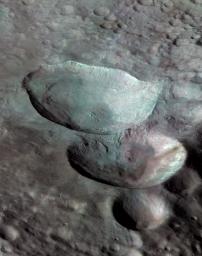
|
Near-True Color Image of Snowman
- Click the image above for a larger view
- Full-Res JPEG (2600 x 3300) (743.3 kB)
- Full-Res TIFF (2600 x 3300) (25.8 MB)
Caption:
Three impact craters of different sizes, arranged in the shape of a snowman, make up one of the most striking features on Vesta, as seen in this view from NASA's Dawn mission. In this view the three "snowballs" are upside down, so that the shadows make the features easily recognizable. North is to the lower right in the image, which has a resolution of 230 feet (70 meters) per pixel
The image is composed of many individual photographs taken between October and December 2011 by Dawn's framing camera. They were obtained during the high-altitude mapping orbit, at about 420 miles (680 kilometers) above Vesta's surface.
The largest of the three craters, Marcia, has a diameter of about 40 miles (60 kilometers). The central crater, which is about 30 miles (50 kilometers) in diameter, is named Calpurnia, and the lower crater, named Minucia, has a diameter of about 14 miles (22 kilometers). Marcia and Calpurnia are possibly the result of an impact by doublet asteroids, whereas Minucia was formed by a later impact.
To derive the color information, scientists combined images acquired by the framing camera in two near-infrared channels (0.917 microns and 0.749 microns) and an ultraviolet channel (0.438 microns). The true colors of the surface of Vesta differ somewhat from what is displayed here, but this mode of reproduction allows subtle changes in material properties across the craters and material ejected from impacts to be detected. In both Marcia and Calpurnia, landslides can be seen; also, dark material has been exposed below the rim of Marcia.
Background Info:
The Dawn mission to Vesta and Ceres is managed by NASA's Jet Propulsion Laboratory, a division of the California Institute of Technology in Pasadena, for NASA's Science Mission Directorate, Washington. UCLA is responsible for overall Dawn mission science. The Dawn framing cameras were developed and built under the leadership of the Max Planck Institute for Solar System Research, Katlenburg-Lindau, Germany, with significant contributions by DLR German Aerospace Center, Institute of Planetary Research, Berlin, and in coordination with the Institute of Computer and Communication Network Engineering, Braunschweig. The framing camera project is funded by the Max Planck Society, DLR and NASA/JPL.
More information about Dawn is online at http://www.nasa.gov/dawn and http://dawn.jpl.nasa.gov .
Cataloging Keywords:
| Name | Value | Additional Values |
|---|---|---|
| Target | 4 Vesta | |
| System | Main Belt | |
| Target Type | Asteroid | |
| Mission | Dawn | |
| Instrument Host | Dawn | |
| Host Type | Orbiter | |
| Instrument | Framing Camera (FC) | |
| Detector | ||
| Extra Keywords | Color, Crater, Impact, Infrared, Shadow, Ultraviolet | |
| Acquisition Date | ||
| Release Date | 2012-05-10 | |
| Date in Caption | ||
| Image Credit | NASA/JPL-Caltech/UCLA/MPS/DLR/IDA | |
| Source | photojournal.jpl.nasa.gov/catalog/PIA15674 | |
| Identifier | PIA15674 | |
